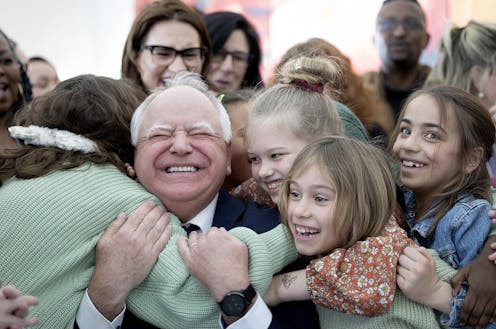Free school meals are on the rise in the US − but that could change depending on who wins the 2024 presidential election
- Written by Marlene B. Schwartz, Professor of Human Development and Family Sciences, University of Connecticut

Should all U.S. public school students be able to eat breakfast and lunch at no cost, regardless of their family’s income[1]? The federal government temporarily made that possible during the COVID-19 pandemic. Since then, some states have taken it upon themselves to make it happen on a permanent basis. The Conversation U.S. asked Marlene B. Schwartz[2] and Juliana Cohen[3], two scholars of school nutrition, to explain why this issue has become more prominent and what they expect the next presidential administration to do about it.
How many K-12 students get free meals at school?
The National School Lunch Program provides nutritious meals for over 28 million students each day[5]. Students living in low-income households can receive meals for free or at a reduced price[6]. However, there can be barriers to participating in school meals for families, including the stigma associated with receiving free meals or challenges completing school meal applications. Many families are also not eligible for free or reduced-price meals but may be struggling financially. Overall, this can lead to school meal debt[7] if a child eats breakfast or lunch at school but the family cannot afford the cost[8].
In March 2020[9], Congress realized that more students might face food insecurity[10] – not having consistent access to enough nutritious food – due to school closures in response to the COVID-19 pandemic. So lawmakers temporarily authorized the U.S. Department of Agriculture to provide school meals at no cost for all students nationwide and to give schools more flexibility in terms of how they could distribute food to families with children.
This unexpected natural experiment[11] illustrated the benefits of providing healthy meals for all children[12]. Eight states[13] – California, Colorado, New Mexico, Maine, Massachusetts, Michigan, Minnesota and Vermont – have chosen to provide free meals for all public school students since the USDA stopped funding universal free school meals[14] after the 2021-22 school year.
There is evidence that families with children living in states that provide free meals across the board have lower rates of food insufficiency[15], another way to measure the share of people who can’t get enough food on the table.
Some states have instead opted to expand access to free meals without making them universal, including Connecticut, Arizona, Louisiana and Texas. They are providing free meals to students who were previously eligible for reduced-price meals. New Jersey has increased[16] the number of students with access to free meals at its public schools by 60,000.
At the federal level, the USDA expanded access to the Community Eligibility Provision[17] in the fall of 2023. This enables individual schools or entire school districts with large numbers of low-income students to provide free meals to all students. This policy was originally implemented as part of the Obama administration’s Healthy, Hunger-Free Kids Act of 2010. The number of schools where all kids get free meals is rising[18]. Nearly 20 million U.S. children attended a public or charter school participating in the Community Eligibility Provision during the 2022-23 school year, up 22.5% from the prior school year.
Due to all the steps taken to increase access to free meals, about two-thirds of public and charter school students received school meals for free[19] during the 2023-24 school year.
What does the latest research say about universal free school meals?
A large body of research[20] has found that universal free school meals benefit students.
When the meals served at school are free for everybody, studies have found that more students eat them, including students who were already eligible for free school meals.
This could happen because providing free meals to all children may reduce the stigma[21] of eating school meals.
A literature review we conducted[22] with several colleagues found that providing lunch at no cost for all students was associated with multiple positive outcomes: better nutrition, lower food insecurity rates, higher attendance and higher academic achievement.
The nutrition finding makes sense in light of research documenting that school meals are usually healthier[23] than what children eat at home and elsewhere. We are working on a new study that assesses whether the families of students at schools with universal free meals are less likely to experience food insecurity because they can spend more money on food eaten at home.
Free meals also mean students run no risk of incurring unpaid school meal debt[24]. This debt can take a toll on kids, their families and even their schools, which often have to use other operational funds to cover this debt.
In states without universal free school meal policies, unpaid school meal debt continues to climb[25]. In the fall of 2023, this debt ranged from as little as US$10 up to $1 million per school district. The median amount was about $5,500 – more than double the debt owed a decade earlier.
Why did Walz make this a priority in Minnesota?
In March 2023, Gov. Tim Walz signed a measure into law making all meals served at the state’s public and charter schools free[26]. It also eliminated all preexisting school meal debt.
As a former teacher, Walz recognized the benefits of free meals. “It makes a huge difference in the lives of those families and the savings they see,” he said in January 2024[27]. “It makes a huge difference in the moment for those students, and we know in the long run it’ll make a difference in achievement and the well-being of those students.”
What might happen in a Harris-Walz administration?
Universal free school meals has been a priority for Walz in Minnesota, and as such, we are optimistic that a Harris-Walz administration would recognize the potential benefits of making school meals available at no cost for all children in the United States. Another option would be to boost federal funding to enable more schools to participate in the Community Eligibility Provision.
Gov. Tim Walz, Kamala Harris’ running mate, has boasted on the campaign trail about his state making school meals free for all students.What would you expect to see in a second Trump administration?
Donald Trump’s administration made multiple attempts to weaken the nutritional quality of school meals[28] despite evidence supporting their benefits for students. For example, they rolled back expectations that kids would be served more whole grains[29] and stalled efforts to decrease sodium levels.
Project 2025[30], a package of policy proposals authored by people closely tied to Trump’s 2024 presidential bid – but that the campaign has sought to disavow – calls for cuts in federal spending[31] that helps fund universal free school meal programs.
It also recommends eliminating the Community Eligibility Provision[32], a step that[33] many Republican lawmakers support[34]. We would expect a second Trump administration to weaken the positive impacts of school meal programs.
References
- ^ regardless of their family’s income (www.youtube.com)
- ^ Marlene B. Schwartz (scholar.google.com)
- ^ Juliana Cohen (scholar.google.com)
- ^ Alejandra Villa Loarca/Newsday RM via Getty Images (www.gettyimages.com)
- ^ over 28 million students each day (www.fns.usda.gov)
- ^ free or at a reduced price (www.fns.usda.gov)
- ^ school meal debt (www.npr.org)
- ^ family cannot afford the cost (doi.org)
- ^ In March 2020 (www.fns.usda.gov)
- ^ more students might face food insecurity (theconversation.com)
- ^ natural experiment (doi.org)
- ^ healthy meals for all children (usafacts.org)
- ^ Eight states (www.nycfoodpolicy.org)
- ^ stopped funding universal free school meals (fns-prod.azureedge.us)
- ^ lower rates of food insufficiency (www.ers.usda.gov)
- ^ New Jersey has increased (www.nj.gov)
- ^ Community Eligibility Provision (www.fns.usda.gov)
- ^ schools where all kids get free meals is rising (frac.org)
- ^ two-thirds of public and charter school students received school meals for free (www.fns.usda.gov)
- ^ large body of research (doi.org)
- ^ reduce the stigma (doi.org)
- ^ A literature review we conducted (doi.org)
- ^ school meals are usually healthier (now.tufts.edu)
- ^ unpaid school meal debt (schoolnutrition.org)
- ^ unpaid school meal debt continues to climb (schoolnutrition.org)
- ^ meals served at the state’s public and charter schools free (www.theguardian.com)
- ^ he said in January 2024 (minnesotareformer.com)
- ^ weaken the nutritional quality of school meals (www.fns.usda.gov)
- ^ rolled back expectations that kids would be served more whole grains (doi.org)
- ^ Project 2025 (theconversation.com)
- ^ calls for cuts in federal spending (static.project2025.org)
- ^ eliminating the Community Eligibility Provision (www.fns.usda.gov)
- ^ a step that (www.nytimes.com)
- ^ many Republican lawmakers support (www.nytimes.com)
Authors: Marlene B. Schwartz, Professor of Human Development and Family Sciences, University of Connecticut




